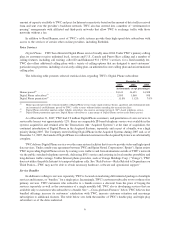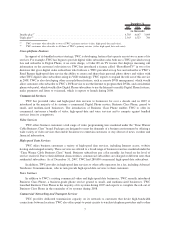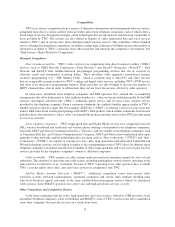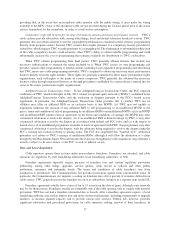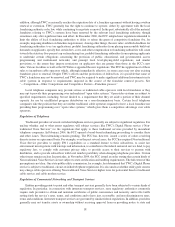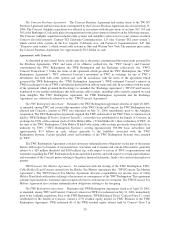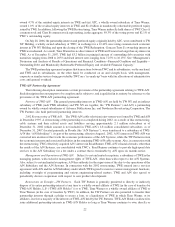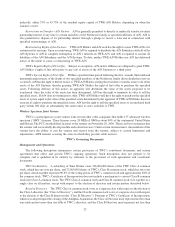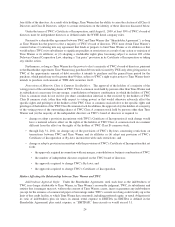Time Warner Cable 2007 Annual Report Download - page 21
Download and view the complete annual report
Please find page 21 of the 2007 Time Warner Cable annual report below. You can navigate through the pages in the report by either clicking on the pages listed below, or by using the keyword search tool below to find specific information within the annual report.investor-owned utilities. The Communications Act also requires the FCC to regulate the rates, terms and conditions
imposed by these utilities for cable systems’ use of utility pole and conduit space unless state authorities
demonstrate to the FCC that they adequately regulate pole attachment rates, as is the case in some states in
which TWC operates. In the absence of state regulation, the FCC administers pole attachment rates on a formula
basis. The FCC’s original rate formula governs the maximum rate utilities may charge for attachments to their poles
and conduit by cable operators providing cable services. The FCC also adopted a second rate formula that became
effective in February 2001 and governs the maximum rate investor-owned utilities may charge for attachments to
their poles and conduit by companies providing telecommunications services. The U.S. Supreme Court has upheld
the FCC’s jurisdiction to regulate the rates, terms and conditions of cable operators’ pole attachments that are being
used to provide both cable service and high-speed data service. The applicability of this determination to TWC’s
voice services is still an open issue. In November 2007, the FCC issued a Notice of Proposed Rulemaking that
proposes to establish a single pole attachment rate for all companies providing broadband internet access service.
Set-top box regulation. Certain regulatory requirements are also applicable to set-top boxes. Currently, many
cable subscribers rent from their cable operator a set-top box that performs both signal-reception functions and
conditional-access security functions. The lease rates cable operators charge for this equipment are subject to rate
regulation to the same extent as basic cable service. Cable operators are allowed to set equipment rates for set-top
boxes, CableCARDs and remote controls on the basis of actual capital costs, plus an annual after-tax rate of return
of 11.25%, on the capital cost (net of depreciation). In 1996, Congress enacted a statute seeking to allow subscribers
to use set-top boxes obtained from third party retailers. The most important of the FCC’s implementing regulations
became effective on July 1, 2007 and requires cable operators to cease placing into service new set-top boxes that
have integrated security so that subscribers can purchase set-boxes or other navigational devices from other sources.
Direct broadcast operators are not subject to this requirement and certain incumbent telephone operators that
provide cable service have received a limited waiver from the FCC.
In December 2002, cable operators and consumer-electronics companies entered into a standard-setting
agreement relating to reception equipment that uses a conditional-access security card—a CableCARD—provided
by the cable operator to receive one-way cable services. To implement the agreement, the FCC adopted regulations
that (i) establish a voluntary labeling system for such one-way devices; (ii) require most cable systems to support
these devices; and (iii) adopt various content-encoding rules, including a ban on the use of “selectable output
controls.” The FCC has initiated a notice of proposed rulemaking that may lead to regulations covering equipment
sold at retail that is designed to receive two-way products and services, which, if adopted, could increase TWC’s
cost in supporting such equipment.
Exclusive arrangements with Multiple Dwelling Units. In November 2007, the FCC adopted an order
declaring null and void all exclusive access arrangements between cable operators and multiple dwelling units and
other centrally managed real estate developments (“MDUs”). In connection with the order, the FCC also issued a
Further Notice of Proposed Rulemaking regarding whether to expand the ban on exclusivity to other types of multi-
channel video programming distributors (“MVPDs”) in addition to cable operators, including DBS providers, and
whether additional types of exclusivity arrangements between MVPDs and MDUs not addressed in the order should
be prohibited. The FCC indicated it would issue an order resolving these issues within six months from release of
the final order adopting the new regulation. In December 2007, the National Cable and Telecommunications
Association (“NCTA”) filed a stay request at the FCC and an appeal in the U.S. Court of Appeals for the District of
Columbia Circuit on the issue of whether the FCC has the authority to prohibit the enforcement of existing contracts
between MDUs and cable operators.
Other regulatory requirements of the Communications Act and the FCC. The Communications Act also
includes provisions regulating customer service, subscriber privacy, marketing practices, equal employment
opportunity, technical standards and equipment compatibility, antenna structure notification, marking, lighting,
emergency alert system requirements and the collection from cable operators of annual regulatory fees, which are
calculated based on the number of subscribers served and the types of FCC licenses held.
Separately, the FCC has adopted cable inside wiring rules to provide specific procedures for the disposition of
residential home wiring and internal building wiring where a subscriber terminates service or where an incumbent
cable operator is forced by a building owner to terminate service in a MDU. The FCC has also adopted rules
16


